Category: International EM
Keywords: Pediatrics, Disaster (PubMed Search)
Posted: 10/23/2013 by Andrea Tenner, MD
Click here to contact Andrea Tenner, MD
General Information:
Area of the world affected:
Bottom Line:
University of Maryland Section of Global Emergency Health
Author: Emilie J.B. Calvello, MD, MPH
Rothstein, D. Pediatric Care in Disasters. Pediatrics. 2013, 132;25.
Category: Critical Care
Keywords: TRALI, TACO, Transfusion, acute lung injury (PubMed Search)
Posted: 10/22/2013 by Feras Khan, MD
Click here to contact Feras Khan, MD
Background
Definition
Pathogenesis
Two-hit hypothesis: first hit is underlying patient factors causing adherence of neutrophils to the pulmonary endothelium; second hit is caused by mediators in the blood transfusion that activate the neutrophils and endothelial cells.
Differential
Can be confused or overlap with TACO or transfusion-associated volume/circulatory overload, which presents similarly but has evidence of increased BNP, CVP, pulmonary wedge pressure, and left sided heart pressures. Patients with TACO tend to improve with diuretic treatment
Supportive tests
Treatment
Lancet. 2013 Sep 14;382(9896):984-94. doi: 10.1016/S0140-6736(12)62197-7. Epub 2013 May 1.
Category: Visual Diagnosis
Posted: 10/20/2013 by Haney Mallemat, MD
(Updated: 12/5/2023)
Click here to contact Haney Mallemat, MD
55 year-old male presents with chest pain. You take a look at his cardiac function with ultrasound and here's the patient's apical four-chamber view. What's in his right ventricle and why would it be there?
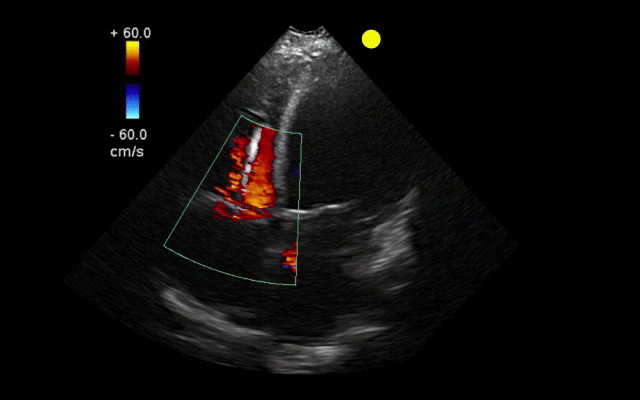
AICD
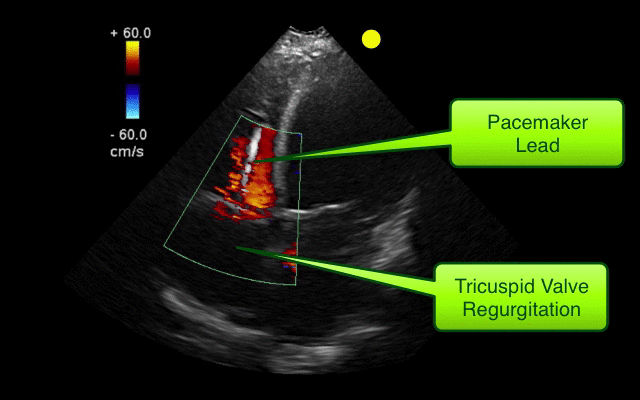
Follow me on Twitter (@criticalcarenow) or Google+ (+criticalcarenow)
Category: Cardiology
Posted: 10/20/2013 by Semhar Tewelde, MD
Click here to contact Semhar Tewelde, MD
Ebstein's Anomaly
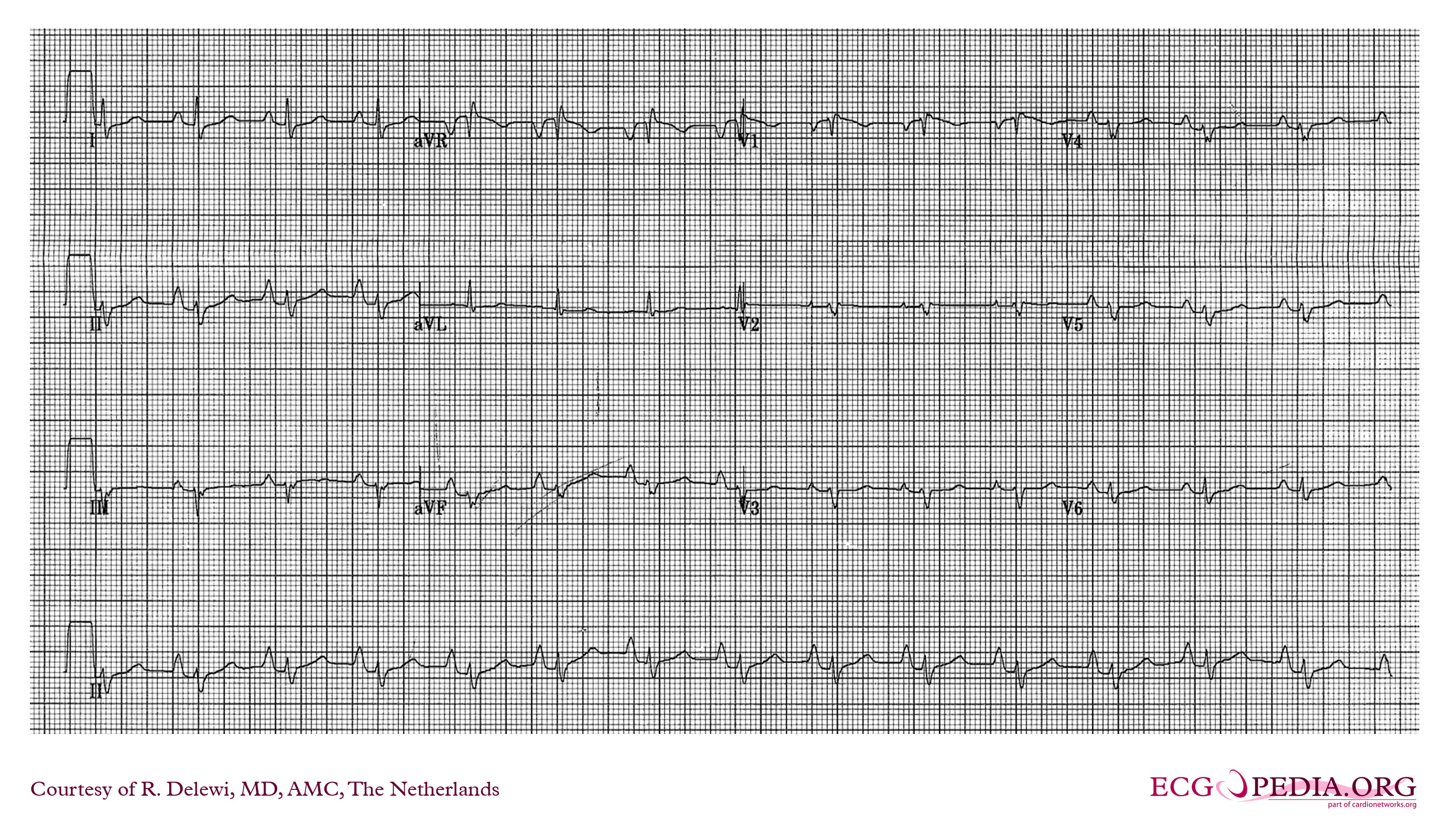
Osiro S, Tiwari K, Mathenge N, et al. When Lithum Hurts: A Look at Ebstein Anomaly. Cardiology in Review. Oct 2013, Vol 21(5); pgs 257-263.
Category: Pediatrics
Keywords: skull fracture (PubMed Search)
Posted: 10/18/2013 by Jenny Guyther, MD
(Updated: 12/14/2025)
Click here to contact Jenny Guyther, MD
Pediatric patients with an isolated skull fracture and normal neurological exam have a low risk of neurosurgical intervention and outpatient follow up may be appropriate (assuming no suspicion of abuse and a reliable family). In a study published in 2011, a retrospective review over a 5 year period at a level 1 trauma center showed that 1 out of 171 admitted patients with isolated skull fractures developed vomiting. This patient had a follow up CT showing a small extra-axial hematoma that did not require intervention. 58 patients were discharged from the ED within 4 hours.
You can also check out another recent article published in Annals of Emergency Medicine on the same topic this month!
Rollins et al. Neurologically intact children with an isolated skull fracture may be safely discharged after brief observation. Journal of Pediatric Surgery. Volume 26. Issue 7. 2011.
Mannix et al. Skull Fractures: Trends in Management in US Pediatric Emergency Departments. Annals of Emergency Medicine. Volume 64. Issue 4. 2013.
Category: Toxicology
Keywords: Hearing loss (PubMed Search)
Posted: 10/17/2013 by Fermin Barrueto
(Updated: 12/14/2025)
Click here to contact Fermin Barrueto
Drugs that cause hearing loss:
Reversible - Chloroquine, erythromycin, quinine, CO, loop diuretics, NSAIDS, ASA
Irreversible - aminoglycosides, bleomycin, vincristine, vinblastine, cisplatin, lead, mercury, arsenic
Adapted from Goldfranks Toxicological Emergencies 8th ED, p. 344
Category: International EM
Keywords: trachoma, international, blindness, infection (PubMed Search)
Posted: 10/16/2013 by Andrea Tenner, MD
Click here to contact Andrea Tenner, MD
General Information:
Trachoma is the leading cause of preventable blindness caused by an infectious disease. It is spread by direct contact with people, objects, or flies carrying Chlamydia trachomatis. Blindness occurs due to corneal scarring with repeated infections (severe scaring of the eyelid-->eyelid inversion-->repeated corneal abrasions).
Clinical Presentation:
-Mild: Hypopigmented follicles on the inner eyelid; Moderate: inner eyelid scarring/eyelash inversion; Severe: corneal scarring/blindness (irreversible)
Diagnosis:
- Clinical: eyelid eversion and careful examination looking for the above
Treatment:
- Azithromycin 20mg/kg ONE TIME DOSE (preferred)
- 1% Tetracycline ointment bid x6 weeks
- If scarring or eyelid inversion is present, surgery is needed.
Bottom Line:
Trachoma is a clinical diagnosis and easy to treat early with a single dose of antibiotics. Patients with late findings should be referred for surgery.
University of Maryland Section of Global Emergency Health
Author: Andi Tenner, MD, MPH, FACEP
Trachoma control: a guide for programme managers. World Health Organization. 2006. Accessed on 16 Oct 2013 at: http://www.who.int/blindness/publications/tcm%20who_pbd_get_06_1.pdf
Category: Critical Care
Posted: 10/16/2013 by Haney Mallemat, MD
Click here to contact Haney Mallemat, MD
There have been so many great talks at ACEP 2013, but Dr. Michael Winters' talk "The ICU is NOT Ready for Your Patient" was chock full of great critical care pearls. Here are just a few:
Follow me on Twitter (@criticalcarenow) or Google+ (+criticalcarenow)
Category: Visual Diagnosis
Posted: 10/14/2013 by Haney Mallemat, MD
Click here to contact Haney Mallemat, MD
A 23 year-old male presents with the rash below. He originally presented to his primary care doctor for a sore throat and was given a prescription for a medication; this rash subsequently broke out. What's the diagnosis and which medication did he receive?
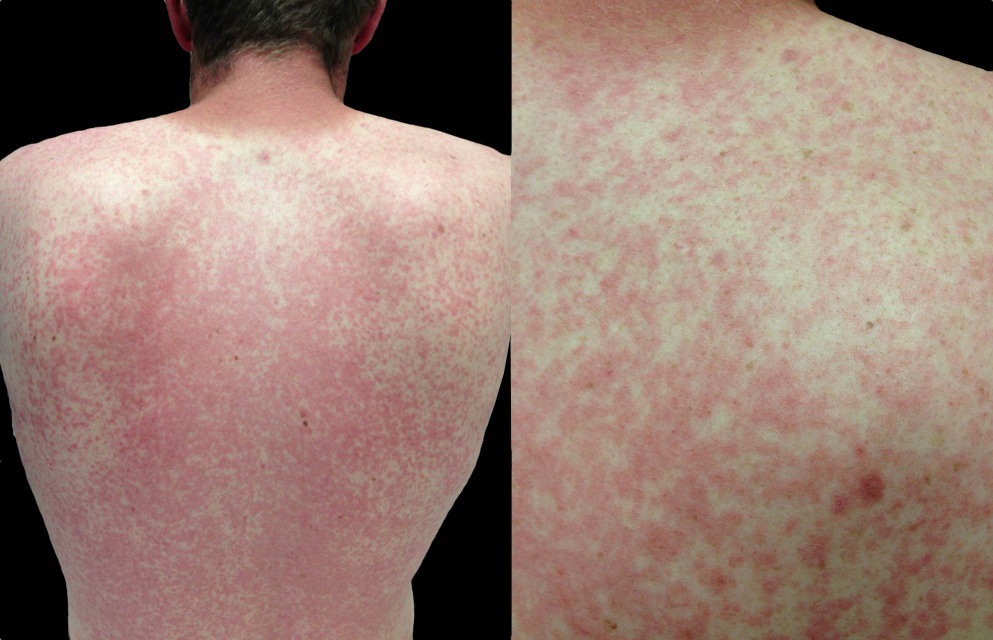
Rash secondary to Epstein-Barr pharyngitis treated with amoxicillin
Luzuriaga, K., Sullivan, J. Infectious Mononucleosis. N Engl J Med 2010; 362:1993-2000
Follow me on Twitter (@criticalcarenow) or Google+ (+criticalcarenow)
Category: Cardiology
Keywords: Dyspnea, Chest Pain (PubMed Search)
Posted: 10/13/2013 by Ali Farzad, MD
(Updated: 3/10/2014)
Click here to contact Ali Farzad, MD
A 48 year-old female presents to the ED with progressive dyspnea and chest discomfort over the past 3 months. HR = 105, BP = 100/60 mmHg, with mild JVD on exam. Her ECG is shown below. What ECG abnormalites are present? What does your differential diagnosis include? What is the best initial diagnostic test?
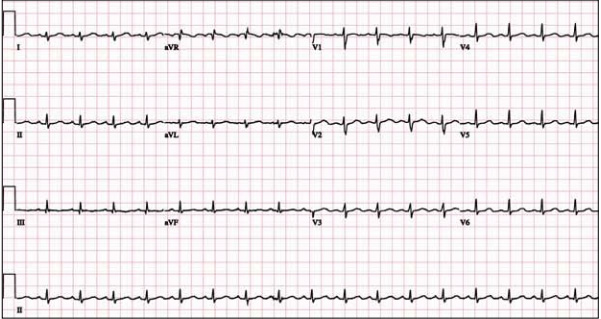
The ECG shows sinus tachycardia at rate of 107 with low QRS voltage diffusely. Echocardiogram revealed significant pericardial effusion with signs of impending tamponade. Emergent pericardiocentesis was performed and her symptoms improved.
Low QRS voltage (LQRSV)
LQRSV Differential
Want more emergency cardiology pearls? Follow me @alifarzadmd
Category: Toxicology
Keywords: nms, neuroleptic malignant syndrome, anti-NMDAR encephalitis (PubMed Search)
Posted: 10/4/2013 by Bryan Hayes, PharmD
(Updated: 10/10/2013)
Click here to contact Bryan Hayes, PharmD
Toxicologists should be aware of non-toxicological mimics of delirium, including anti-NMDA receptor encephalitis. It is an under-recognized progressive neurological disorder caused by antibodies against NMDA receptors.
Cases often present with altered mental status, autonomic instability, increased muscle tone, and movement disorders. It can easily be mistaken for neuroleptic malignant syndrome (NMS). A new case series describes two such patients for which toxicologists were consulted.
Must read links:
Dr. Leon Gussow provides a great review of the case series on his Poison Review blog.
Dr. Chris Nickson reviews the basics of the disease on the Life in the Fast Lane blog.
Anti-N-methyl-D-aspartate receptor (anti-NMDAR) encephalitis: an etiology worth considering in the differential diagnosis of delirium. Clin Toxicol 2013;51(8):794-7. [PMID 23962100]
Follow me on Twitter (@PharmERToxGuy)
Category: International EM
Keywords: Salmonellosis, Infectious disease, diarrhea (PubMed Search)
Posted: 10/9/2013 by Andrea Tenner, MD
Click here to contact Andrea Tenner, MD
General Information:
Area of the world affected:
Relevance to the US physician:
Bottom Line:
Suspect Salmonellosis in patients with appropriate exposure and symptoms, give supportive care for most, only give antibiotics to severely ill patients after sending blood and stool culture and sensitivities.
University of Maryland Section of Global Emergency Health
Author: Andi Tenner, MD, MPH
http://www.cdc.gov/salmonella/heidelberg-10-13/index.html
Category: Critical Care
Keywords: CPR, Cardiac Arrest, ACLS, Chest Compression (PubMed Search)
Posted: 10/4/2013 by John Greenwood, MD
Click here to contact John Greenwood, MD
Want to improve your chances of success in the resus room? Download a metronome app on your smartphone and set it to a rate of 100-120 beats per minute. There are a number of cheap (usually free) metronome applications for both iOS and Android devices.
A recent review looked at the evidence behind CPR feedback devices and found:
So instead of going to iTunes and downloading the Bee Gees, go over to the App store and download a free metronome. Your resus team will be able to stay on track with their compressions and even better - they won't have to hear you sing!
Category: Visual Diagnosis
Posted: 10/7/2013 by Haney Mallemat, MD
Click here to contact Haney Mallemat, MD
25 year-old female struck in the left hand by a football. Presents with pain, visible deformity, and the Xray below. What are the next step(s) in management?
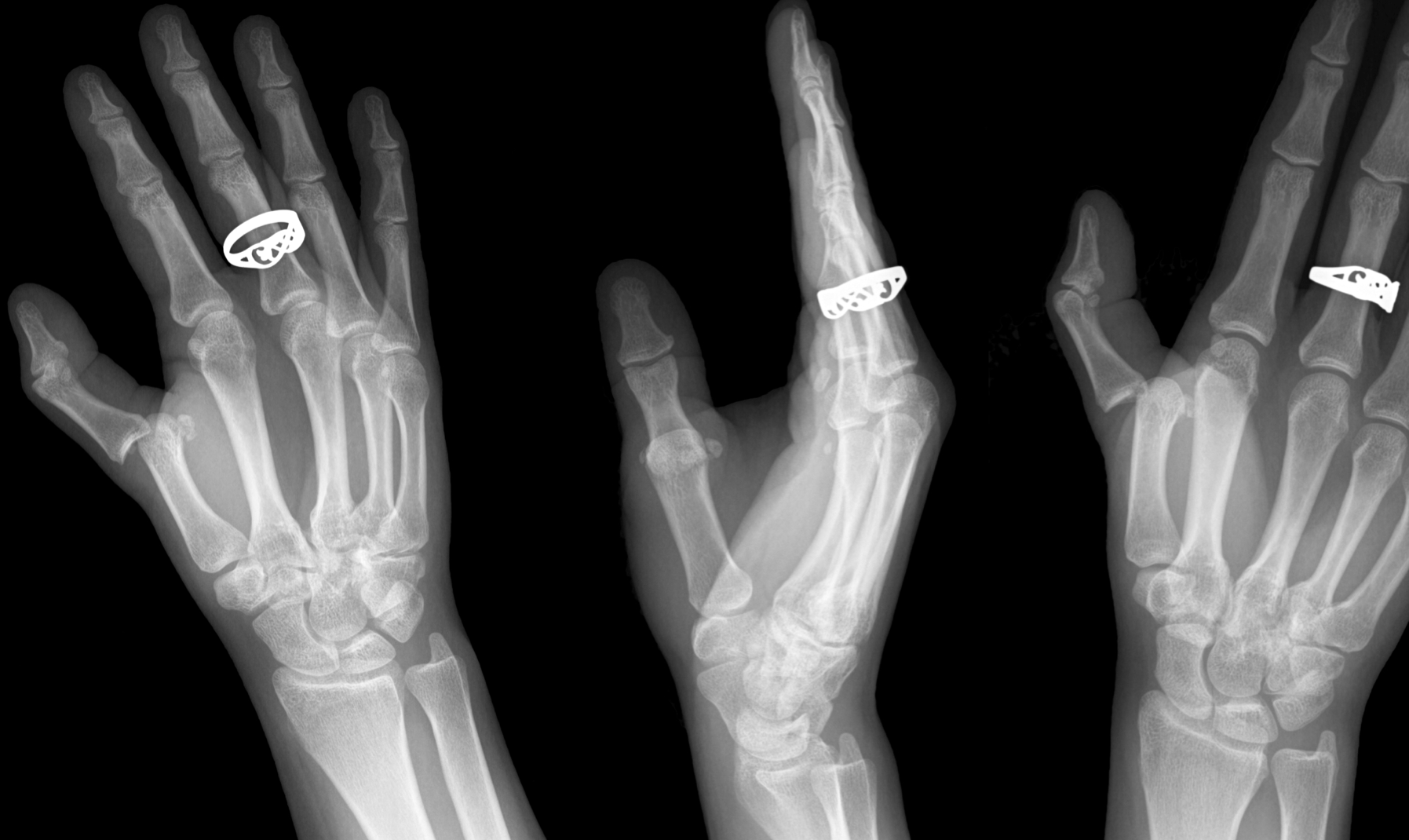
Dorsal Metacarpophalangeal (MCP) Dislocation
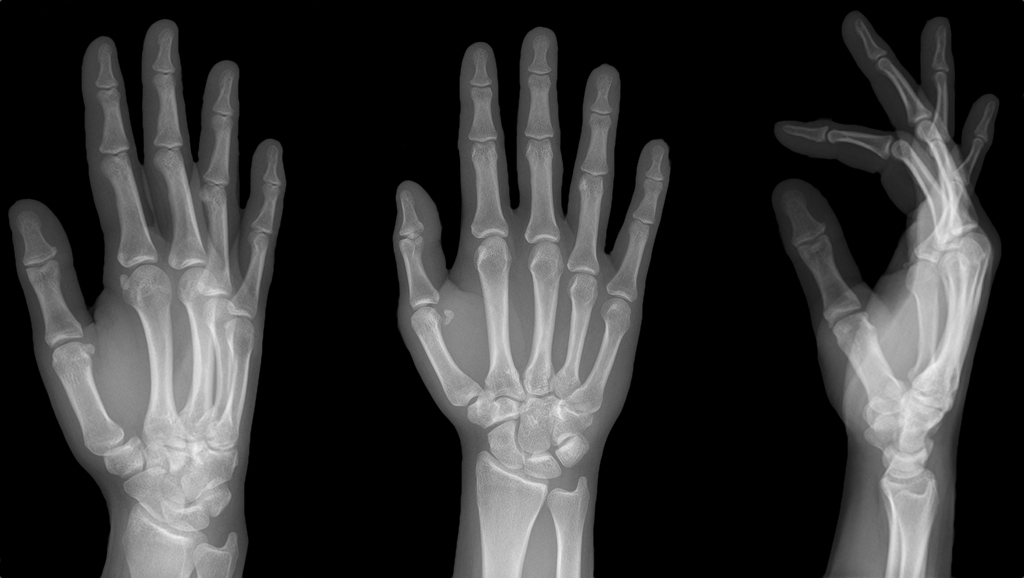
Follow me on Twitter (@criticalcarenow) or Google+ (+criticalcarenow)
Category: Cardiology
Keywords: Aortic Syndrome, Aortic Dissection, Intramural hematoma, Atheromatous ulcer (PubMed Search)
Posted: 10/6/2013 by Semhar Tewelde, MD
Click here to contact Semhar Tewelde, MD
Acute Aortic Syndromes
Classically, aortic dissection is considered the primary culprit in patients with chest pain that radiates to the back (aortic pain) or chest pain combined with ischemia (cerebral, cardiac, peripheral), syncope, or cardiac arrest. However, it should not be your only concern: the rate of aortic rupture is much higher in penetrating atheromatous ulcer (42%) and intramural hematoma (35%) than in aortic dissection (types A 7.5% and type B 4.1%).
Chest pain with concomitant ischemic symptoms and acute decompensation should prompt consideration of several etiologies under the umbrella of aortic syndromes and not limited to dissection :
Sheikh A, Ali K, Mazhar S. Acute Aortic Syndrome. Circulation 2013;128:1122-1127
Coady MA, Rizzo JA, Elefteriades JA. Pathological Variants of thoracic aortic dissection. Penetrating atherosclerotic ulcers and intramural hematomas. Cardiol Clin. 1999;17:637-657
Category: Pharmacology & Therapeutics
Keywords: cryptococcal, meningitis, amphotericin, flucytosine (PubMed Search)
Posted: 9/25/2013 by Bryan Hayes, PharmD
(Updated: 10/5/2013)
Click here to contact Bryan Hayes, PharmD
Treatment of patients with HIV/AIDS can frequently mean consideration for, and need to treat cryptoccocal meningitis.
Since 1997, studies have demonstrated that high-dose Amphotericin B combined with flucytosine has improved outcomes compared to low dose treatment or monotherapy.
A recent 2013 study reiterated this approach, showing significant decrease in deaths at 70 days post-treatment and increased rates of yeast clearance with combination therapy of Amphotericin B plus flucytosine.
Recommendation:
Antifungal treatment of cryptococcal meningitis should start with Amphotericin B at 0.7-1 mg/kg IV daily plus concurrent flucytosine 25 mg/kg orally q6 hours. Fluconazole can be substituted in place of flucytosine if it is not available or not tolerated.
Category: Pediatrics
Keywords: Omphalitis, necrotizing fasciitis, umbilical cord (PubMed Search)
Posted: 10/4/2013 by Joey Scollan, DO
Click here to contact Joey Scollan, DO
Should you be concerned about erythema around the umbilical stump?!
Yes!
Often parents will bring their neonate to the ED with concerns about the umbilical cord and it is just a simple granuloma or normal detachment. But is it omphalitis???
Omphalitis incidence is low in developed countries, but that means it’s easier, and no less catastrophic, to miss!
Omphalitis is a superficial cellulitis of the umbilical cord, but 10-16% progress to necrotizing fasciitis of the abdominal wall!!!
Always ADMIT and consider consulting surgery early in case of rapid progression…
Most often polymicrobial and should be treated with:
Should notice improvement within 12-24 hours, so if don’t or begin to observe
CONSULT SURERY for concern of necrotizing fasciitis which has a mortality rate of close to 60%!!!
Category: Pharmacology & Therapeutics
Keywords: procainamide,atrial fibrillation,prolonged QT,monomorphic VT (PubMed Search)
Posted: 10/3/2013 by Ellen Lemkin, MD, PharmD
Click here to contact Ellen Lemkin, MD, PharmD
ACLS recommendation for procainamide in tachycardic rhythms is:
Loading dose 20 mg/minute (up to 50 mg/minute for more urgent situations) until:
Maintenance infusion is 1 to 4 mg/min.
An easier method for dosing acute onset atrial fibrillation in stable patients was used in the Ottawa Aggressive Protocol, in which they administered 1 gm over 60 min, which was interrupted if BP < 100 mmHg; if corrected by a 250 ml IV bolus, the infusion was resumed. This was not used, however if the patient was to be admitted.
A strategy for treating stable monomorphic VT with procainamide used:
100 mg IV over 1-2 minutes, repeat as necessary until an endpoint of
If no slowing of the tachycardia occurred with a dose of 400 mg, the administration was ceased.
1. Steil IG, Clement CM, Perry JJ et al. Association of the Ottawa Aggressive Protocol with rapid discharge of emergency department patients with recent-onset atrial fibrillation or flutter. CJEM 2010;12(3):181-91.
2. Komura S, Chinushi M, Furushima H. et al. Efficacy of Procainamide and Lidocaine in Terminating Sustained Monomorphic Ventricular Tachycardia. Circulation May 2010 Vol 72
Category: International EM
Keywords: Malaria, Pediatrics, Quinine, Drug Reaction (PubMed Search)
Posted: 10/2/2013 by Andrea Tenner, MD
Click here to contact Andrea Tenner, MD
Case Presentation:
You are working in an ED in Houston when a 2 year old girl presents with fever for one day and decreased po intake. On arrival her temp=103, HR=180, and RR=50 SaO2=100%. She was born in the US and is up to date on all of her vaccinations, but has just returned from a trip to Liberia where she was visiting her extended family and received multiple mosquito bites. Physical exam, CXR and urinalysis are otherwise unremarkable and you suspect malaria, based on her history. You start quinine IV while you are waiting for the smear when suddenly the child becomes unresponsive.
Clinical Question:
What is the next investigation you should perform?
Answer:
Rapid blood glucose!
This patient has at least 4 reasons to be hypoglycemic:
1. fasting (Kids can become hypoglycemic from fasting alone in ~24hrs)
2. infection (any infectious disease can cause it, esp in kids <3 yrs old)
3. malaria (thought to be due in part to increased consumption by parasite)
4. quinine (stimulates insulin release)
Bottom Line:
Kids can become hypoglycemic fast—check a blood glucose in all pre-pubertal sick children.
University of Maryland Section of Global Emergency Health
Author: Andi Tenner, MD, MPH
Zijlmans WCWR et al. Glucose metabolism in children: influence of age, fasting, and infectious diseases. Metabolism Clinical and Experimental. 2009. 58:1356-1365.
Category: Critical Care
Posted: 9/30/2013 by Haney Mallemat, MD
(Updated: 10/1/2013)
Click here to contact Haney Mallemat, MD
The efficacy of epinephrine during out-of hospital cardiac arrest has been questioned in recent years, especially with respect to neurologic outcomes (ref#1).
A recent study demonstrated both a survival and neurologic benefit to using epinephrine during in-hospital cardiac arrest when used in combination with vasopressin and methylprednisolone.
Researchers in Greece randomized 268 consecutive patients with in-hospital cardiac arrest to receive either epinephrine + placebo (control group; n=138) or vasopressin, epinephrine, and methylprednisolone (intervention arm; n=130)
Vasopressin (20 IU) was given with epinephrine each CPR cycle for the first 5 cycles; Epinephrine was given alone thereafter (if necessary)
Methylprednisolone (40 mg) was only given during the first CPR cycle.
If there was return of spontaneous circulation (ROSC) but the patient was in shock, 300 mg of methylprednisolone was given daily for up to 7 days.
Primary study end-points were ROSC for 20 minutes or more and survival to hospital discharge while monitoring for neurological outcome
The results were that patients in the intervention group had a statistically significant:
probability of ROSC for > 20 minutes (84% vs. 66%)
survival with good neurological outcomes (14% vs. 5%)
survival if shock was present post-ROSC (21% vs. 8%)
better hemodynamic parameters, less organ dysfunction, and better central venous saturation levels
Bottom-line: This study may present a promising new therapy for in-hospital cardiac arrest and should be strongly considered.
Follow me on Twitter (@criticalcarenow) or Google+ (+criticalcarenow)
